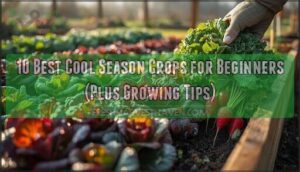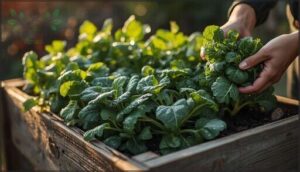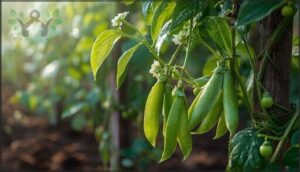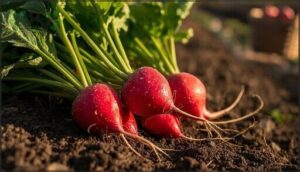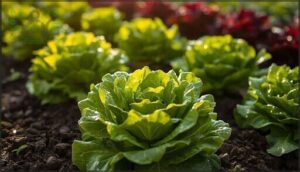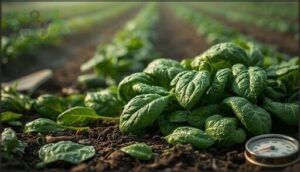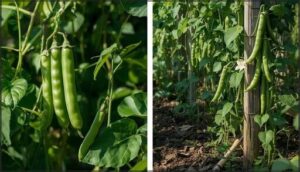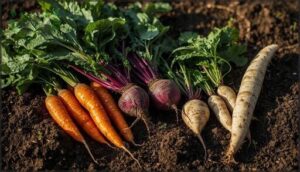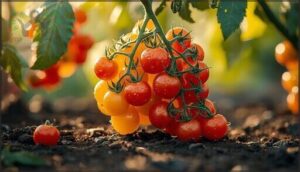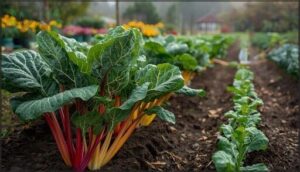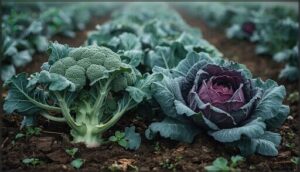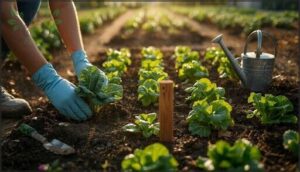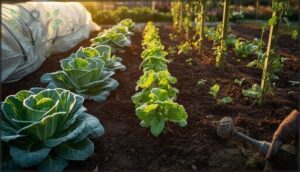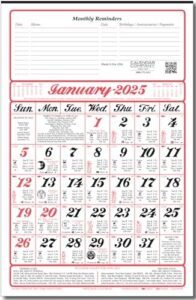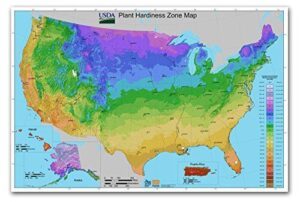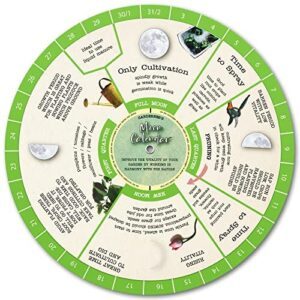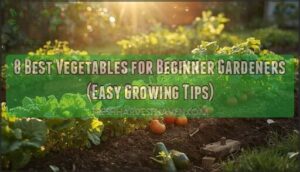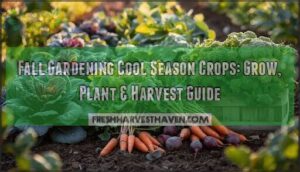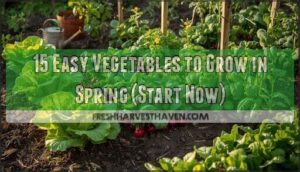This site is supported by our readers. We may earn a commission, at no cost to you, if you purchase through links.
Most gardeners think they need to wait for warm weather to start planting, but that’s when they miss the easiest growing window of the year. Cool season crops like lettuce, spinach, and radishes thrive in temperatures between 40°F and 50°F—conditions that would make tomatoes sulk but send leafy greens into overdrive.
These cold-hardy vegetables can handle frost, grow faster than their warm-season cousins, and often taste sweeter after a light freeze.
If you’re new to gardening, starting with the best cool season crops for beginners gives you quick wins and builds confidence before tackling fussier plants. You’ll discover varieties that germinate in days, tolerate beginner mistakes, and reward you with fresh harvests in less than a month.
Table Of Contents
- Key Takeaways
- Best Cool Season Crops for Beginners
- Easy Planting and Care Tips
- Maximizing Success With Cool Season Crops
- Top Products for Cool Season Gardening
- Frequently Asked Questions (FAQs)
- Can you plant cool season vegetables directly in the garden?
- What plants are best for a cool-season garden?
- What is a cold season vegetable?
- Can vegetables grow in cold weather?
- Can you grow vegetables in the fall?
- Are spring and fall vegetables more productive?
- When should I start planting cool season crops?
- Can I grow cool season crops in containers?
- How do I protect crops from unexpected freezes?
- What are the best fertilizers for cool weather vegetables?
- Conclusion
Key Takeaways
- Cool-season crops like lettuce, spinach, and radishes thrive in 40°F to 50°F temperatures and tolerate frost, making spring and fall the easiest growing windows when warm-season plants struggle.
- Direct sowing works best for root crops that dislike transplanting, while starting seedlings indoors can boost early yields by up to 50% for crops like brassicas and tomatoes.
- Succession planting every 2-3 weeks extends harvests by 8-12 weeks and increases overall yield by 50%, turning a single planting into months of continuous production.
- Disease-resistant varieties preserve 70-98% of yields during outbreaks and cut fungicide use nearly in half, making variety selection one of your most effective gardening strategies.
Best Cool Season Crops for Beginners
Cool season crops thrive in temperatures between 40°F and 50°F, making them perfect for spring and fall gardening when most warm-weather plants struggle. These vegetables are naturally frost-resistant and can handle chilly mornings without missing a beat.
Below are ten beginner-friendly options that grow quickly, forgive common mistakes, and deliver reliable harvests when you need them most.
Baby Greens (arugula, Kale, Mustard Greens)
Baby greens like arugula, kale, and mustard greens are perfect cool-season crops for beginners. You’ll enjoy harvesting them in just 20 to 30 days, and with a proper sowing density of 2 to 3 seeds per inch, you can get multiple cuts per planting.
These greens offer impressive nutritional benefits, including high levels of protein and minerals, while showing solid pest resistance that makes growing them truly rewarding.
You can increase yields by planting in raised beds to improve soil drainage.
Peas
From leafy harvests, you’ll love moving on to peas. These cool-season champions tolerate frost down to 14°F and thrive in soil with a pH between 5.5 and 7.0, making them forgiving for beginner gardening. Many varieties, such as Alderman/Tall Telephone, exhibit resistance to common wilt.
- Plant seeds 1-2 inches deep in temperatures above 40°F for best germination
- Choose disease-resistant pea varieties like Geneva 1 for reliable yields
- Harvest snap peas when pods plump up, usually around 60 days after planting
Radishes
If you want an early harvest that practically grows itself, radishes are your best bet. These cool-season crops mature in just 20–30 days, letting you celebrate your first vegetable gardening success quickly. Plant seeds 1 inch apart in rows 6 inches apart, aiming for seeding at 10-day intervals throughout spring for continuous yields.
| Radish Varieties | Days to Maturity | Best Growing Temperature |
|---|---|---|
| Regular Market Types | 21–28 days | 40–50°F |
| Chinese/Daikon | 50–90 days | 40–50°F |
| Black Radish | 30–45 days | 40–50°F |
| Oilseed Radish | 60–75 days | 45–55°F |
| Winter Radish | 50–70 days | 35–50°F |
For pest control in beginner gardening, watch for diamondback moths and aphids. Your soil requirements aren’t demanding—radishes tolerate poor conditions better than most root crops. Harvesting tips: pull when roots reach marble to golf ball size for peak flavor and crispness.
Lettuce
Lettuce varieties make an ideal next step for beginners because they’re foolproof cool-season crops. You’ll get harvests in just 40–60 days for leaf types, while head lettuce needs 70–80 days. Plant seeds ¼ to ⅜ inch deep in soil with a pH between 6.0 and 6.7.
- Space leaf lettuce 9–12 inches apart in double rows
- Keep growth temperatures between 60–65°F for bolting prevention
- Water consistently—lettuce has high moisture needs
- Harvest outer leaves regularly using cut-and-come-again harvesting methods
Spinach
Spinach stands out among cool season crops because it delivers impressive nutrition—one cup gives you 144.87 mcg of vitamin K plus nearly 1 mg of iron.
You’ll succeed best planting seeds when soil temperatures reach 40–70°F, spacing them to allow proper air circulation. Expect harvest in 40–70 days, but watch for downy mildew since even 1% infection can mean crop rejection in this powerhouse vegetable garden staple.
Green Beans
Green beans rank among the easiest cool-season crops for beginners, with bush and pole bean varieties giving you flexibility in your garden layout.
Plant seeds 1 to 1.5 inches deep once soil reaches 60°F, spacing them 3–4 inches apart. You’ll harvest in just 50–60 days.
Pest control matters—thrips and pod borers can reduce your yield without proper management.
Root Vegetables (carrots, Beets, Turnips, Parsnips)
Root vegetables thrive in temperatures between 50°F and 70°F, making them reliable choices for cool-season gardens. You’ll find success with carrots, beets, turnips, and parsnips when you follow these guidelines:
- Prepare loose, stone-free soil at least 8–12 inches deep for straight root growth
- Plant seeds ½ to 1 inch deep with 1.5–4 inches spacing between them
- Maintain even moisture without waterlogging to prevent root rot
- Practice crop rotation to reduce pest pressure naturally
- Harvest carrots in 60–70 days, beets in 50–60 days, and turnips in 70–90 days
Proper seed spacing and soil preparation directly influence your harvest quality and yield.
Small Fruited Tomatoes
Small fruited tomatoes like ‘Sun Gold’ and ‘Sweet 100’ aren’t typical cool-season crops, but you can start them indoors 6–8 weeks before your last frost for earlier harvests.
These tomato varieties mature in 57–70 days and resist fusarium wilt and mosaic virus, making them beginner-friendly.
Their nutritional benefits include 86% daily vitamin A and disease resistance that extends your growing season with minimal pest management.
Swiss Chard
Swiss chard thrives as one of the easiest cool-season crops for your vegetable garden, producing 8–12 pounds per 10-foot row with minimal fuss. This beginner gardening favorite tolerates light frost down to -9°C and provides impressive chard nutrition—477% daily vitamin K per cooked cup.
- Plant seeds ½ inch deep, spacing plants 6–12 inches apart for yield maximization
- Water daily until established, then maintain moist soil 2 inches below surface
- Harvest leaves continuously from day 55 until several weeks after first frost
- White and yellow varieties show better leafspot control than red types
- Apply compost mid-summer to boost growth and extend your harvest window
Brassicas (broccoli, Cabbage)
Broccoli and cabbage rank among the easiest cool-season crops, delivering impressive harvests when you understand their simple needs. These brassicas thrive in temperatures between 50–77°F and prefer a soil pH range of 5.8 to 6.6 for optimal nutrient uptake.
| Aspect | Broccoli | Cabbage |
|---|---|---|
| Planting Depth | ½ inch | ½ inch |
| Days to Harvest | 50–90 days | 60–90 days |
| Spacing | 14–18 inches | 12–24 inches |
| Fertilizer (N-P-K) | 120-100-100 lbs/acre | Similar needs |
| Disease Resistance | Select resistant varieties | Choose resistant cultivars |
Apply boron at 3 pounds per acre for broccoli to prevent hollow stems. Both vegetables offer outstanding nutritional benefits—broccoli provides 535% more vitamin A than cabbage, while cabbage contains less sodium.
Succession planting every two weeks extends your harvest through spring and fall, maximizing yields per square foot. For beginner gardening tips with easy-to-grow vegetables, start seeds in late summer for fall crops when cooler weather promotes better head formation.
Addressing brassica diseases through genomic advances has improved resistance breeding, giving you reliable harvests. Remember, proper planting timing and fertilizer needs help these cool-season crops reward your efforts generously.
Easy Planting and Care Tips
Once you’ve picked your crops, the next step is getting them in the ground and keeping them happy. The good news is that cool season vegetables are pretty forgiving if you follow a few basic guidelines.
Let’s walk through the essentials that’ll set you up for success from planting day to harvest time.
Direct Sowing Vs. Transplanting
When should you sow seeds directly versus starting them indoors? This choice shapes your yield timing, labor costs, and overall success with cool-season crops. Direct sowing works best for crops that dislike root disturbance—like carrots, radishes, and beets—while transplanting seedlings gives you earlier harvests with tomatoes, peppers, and brassicas.
Here’s what matters most for your beginner gardening guide:
- Germination rates: Peas and arugula thrive when direct sown at 40–55°F, emerging quickly without the stress of transplanting.
- Stress tolerance: Direct-sown plants develop stronger drought resistance through undisturbed root systems, though transplants offer better survival in unpredictable spring weather.
- Seed starting efficiency: Transplanting increases early yields by up to 50% in the first month for crops like artichokes and peppers, but requires more equipment and hardening off time.
Ideal Soil Preparation for Cool Crops
Your soil preparation sets the stage for everything that follows. Loam and silt loam soils offer the best balance of drainage needs and moisture retention, while organic matter like compost doubles nutrient availability over time.
Aim for soil pH between 5.8 and 6.5 for most cool crops, and work in amendments six to twelve months ahead to build fertile soil and boost soil health naturally.
Proper Spacing and Depth for Seeds
Once your soil is ready, seed depth importance becomes clear. Plant most cool-season crops three times their diameter deep. Lettuce needs just 1/8 inch, while peas go down 1 inch.
Spacing for yield matters equally—radishes need 2 to 3 inches apart, and thinning seedlings prevents overcrowding effects. Proper planting techniques give your seedlings room to breathe and roots space to spread without soil compaction limiting growth.
Watering and Moisture Management
Water your cool-season crops about 1 inch weekly, adjusting for rainfall and soil type. Early morning watering practices minimize evaporation, while mulch benefits include slashing water needs by up to two-thirds.
Monitor soil moisture weekly to avoid overwatering risks like root damage and yellowing leaves. Lettuce and spinach lack drought resistance, so consistent watering at ideal frequency keeps these cool-season gardening favorites thriving through spring and fall.
Using Trellises and Supports
When you’re growing peas or pole beans, vertical support transforms your garden space and results. Trellises for support can boost yields by 20-40% while cutting disease problems by 30%. You’ll find garden ergonomics improve too—harvesting at eye level beats constant bending.
Choose trellis materials like sturdy wood or metal, and watch your cool-season crops thrive with better airflow and increased yield potential.
Succession Planting for Continuous Harvest
Staggering your plantings every 2–3 weeks keeps fresh harvests rolling in for 8–12 weeks longer than a single sowing. Focus on quick crops like lettuce, radishes, and spinach using succession planting strategies for continuous vegetable production.
This approach boosts yield extension by 50% through smart space optimization and crop rotation. Just remember management limits—don’t plant 60+ day crops too late before frost hits.
Maximizing Success With Cool Season Crops
Once you’ve got your cool season crops in the ground, a few smart strategies can make the difference between an okay harvest and a truly abundant one. The good news is that most of these techniques are straightforward and don’t require fancy equipment or years of experience.
Let’s look at some practical ways to protect your plants, boost your yields, and keep your garden thriving even when the weather throws you a curveball.
Choosing Disease-Resistant Varieties
You’ll find that disease resistance can be your best defense when selecting CoolSeason Crops. Resistant varieties preserve 70% to 98% of yields during outbreaks, and they cut fungicide use by nearly half.
Check seed catalogs for resistance codes—HR means high resistance to specific diseases like downy mildew or clubroot.
Economic benefits include up to 21.5% profit increases, though remember that resistance limitations exist since pathogens evolve.
Managing Pests Organically
Organic pesticides like neem oil tackle pests without harsh chemicals, and biocontrol methods put nature to work for you. The biological control segment leads the market because it works—beneficial insects handle aphids while companion planting confuses slugs.
- Plant alliums near CoolSeason Crops to repel cabbage worms and carrot flies
- Use French marigolds to attract ladybugs that devour aphids
- Apply insecticidal soap to reduce leaf damage on vulnerable plants
- Introduce natural deterrents like mint to deter flea beetles
Pest resistance in biological controls rarely develops.
Crop Rotation and Companion Planting
Rotation benefits stack up when you alternate plant families each season. Rotating cereals with legumes cuts pest populations by up to 80% and lifts soil fertility dramatically through nitrogen-fixing action.
Rotating plant families each season cuts pest populations by 80% and dramatically boosts soil fertility through natural nitrogen-fixing
Three-to-four crop rotations deliver the largest rotation benefits for your cool-season crops.
| Crop Pairing | Key Benefit |
|---|---|
| Corn + Beans | 13% more grain, 42% higher returns |
| Tomato + Basil | Enhanced pest resistance |
| Brassicas + Garlic | Reduced insect movement |
| Lettuce + Radish | Faster soil turnover |
| Peas + Root Vegetables | Improved soil health |
Extending The Growing Season
You can stretch your harvest weeks or even months beyond the normal growing season with a few practical techniques. Cold frames create microclimates up to 1.5 zones warmer, while raised beds warm up 2–4 weeks earlier than ground-level plots.
Four season-extending methods:
- Lightweight row covers provide 2°F frost protection
- Heavyweight covers shield plants down to 6–10°F
- Organic mulches like straw insulate soil and retain moisture
- Hoop tunnels extend planting dates by three weeks
These tools work together for successful overwintering of cool-season crops.
Regular Harvesting Techniques
Your harvest timing determines how much food you’ll pull from each planting. Picking baby greens every 7 to 10 days keeps them producing for weeks. With succession planting of radishes biweekly, you’ll maintain a continuous harvest without gaps.
Avoid removing more than one-third of leaves per cut to protect root vigor and prevent bolting in cool-season crops like spinach and lettuce.
Understanding Frost Tolerance
Frost tolerance separates the crops you can harvest through November from those that end at the first freeze. Understanding these damage thresholds helps you choose cool-season crops that match your climate’s economic realities.
Very hardy varieties like kale and spinach withstand temperatures below 28°F with survival rates above 85%, while frost-tolerant options like carrots and radishes endure light frosts down to 20°F.
Top Products for Cool Season Gardening
Having the right tools and resources makes cool season gardening much easier, especially when you’re just starting out. A few well-chosen products can help you plan better, understand your growing conditions, and stay organized throughout the season.
Here are some helpful items to think about adding to your gardening toolkit.
1. America’s Original Almanac Calendar 2025
America’s Original Almanac Calendar 2025 has guided gardeners through 139 years of growing seasons, offering daily sunrise and sunset times alongside weather predictions designed for your region.
You’ll find best planting dates for cool-season crops based on lunar cycles, plus fishing guides and frost date forecasts across its 11″ x 17″ pages.
With over 4,900 pieces of information and an 80% repeat purchase rate, this calendar remains a trusted companion for timing your cool-season vegetable gardening efforts with precision and confidence.
Best For: Gardeners and farmers who want traditional almanac wisdom combined with daily weather predictions, lunar planting guides, and fishing forecasts in a wall-hanging format.
- Contains over 4,900 pieces of information including daily sunrise/sunset times, region-specific weather predictions, and optimal planting dates based on lunar cycles
- Trusted for 139 years with an 80% repeat purchase rate, making it a reliable multigenerational planning tool
- Provides comprehensive guidance beyond gardening—includes fishing guides, zodiac signs, moon phases, first aid tips, and household hints
- Paper quality is notably flimsy according to customer feedback, which may affect durability throughout the year
- The traditional paper format and folk-style design may not appeal to users who prefer digital calendars or modern interfaces
- At 11″ x 17″, the size requires dedicated wall space and may be too large for compact living areas
2. Antiguos Maps USA Plant Hardiness Zones
Understanding plant hardiness zones helps you match cool-season crops to your region’s frost dates and temperatures. The Antiguos Maps USA Plant Hardiness Zones poster displays zone boundary shifts from historical comparison to modern data collection, reflecting USDA Plant Hardiness Zone Map updates.
With improved mapping methodology and reduced accuracy discrepancies, you’ll see how warming trends have reclassified many areas. This 24 x 36-inch reference helps you select varieties suited to your zone’s coldest winter temperatures, ensuring your cool-season vegetables thrive reliably year after year.
Best For: Gardeners, educators, and climate enthusiasts who want a historical reference showing how U.S. planting zones have shifted over time due to warming trends.
- Shows zone boundary changes across decades, helping you understand long-term climate patterns and plan perennial crops more strategically.
- High-quality giclee print on durable, water-resistant paper that’s ready to frame and display in your home, office, or classroom.
- Covers all U.S. regions including Hawaii, Alaska, and Puerto Rico, giving you a complete national view at an affordable price.
- Frames aren’t included, so you’ll need to buy one separately to display it properly.
- May show minor creases or imperfections from the digital capture process of the original historical map.
- Focuses on historical data rather than the most current 2023 USDA zones, so you’ll want to cross-reference with updated maps for precise planting decisions.
3. Gardening Moon Phase Perpetual Calendar
Timing your planting with lunar cycles can feel unusual, but the Gardening Moon Phase Perpetual Calendar translates this ancient practice into practical, day-by-day crop guides. This reusable tool divides the 28-day lunar cycle into choice windows for sowing above-ground crops, root vegetables, and rest periods.
Observational trials have documented yield increases up to 15-fold when planting schedules align with full moons compared to new moons. With adoption rates rising 40% since 2020, this perpetual calendar eliminates annual repurchasing while coordinating your cool-season planting schedules with nature’s rhythms.
Best For: Gardeners and farmers who want to align planting schedules with lunar cycles to potentially improve germination rates and crop yields without buying a new calendar each year.
- Reusable design eliminates the need to purchase updated calendars annually, saving money and reducing waste over time.
- Provides clear day-by-day guidance for optimal planting, transplanting, and harvesting windows based on the 28-day lunar cycle.
- Works in any climate zone worldwide, making it versatile for gardeners across different growing regions.
- Some users report the instructions are confusing or difficult to follow initially.
- The laminated cardboard construction may seem overpriced compared to the materials used.
- Scientific evidence for lunar gardening remains mixed, with results varying significantly by crop type and location.
4. The Ultimate Permaculture Design Guide
Building a resilient garden starts with understanding how the pieces fit together. The Definitive Permaculture Design Guide walks you through twelve core design principles, from catching rainwater to integrating companion planting for natural pest reduction.
You’ll discover practical applications like layered food forests, sheet mulching for soil building, and crop rotation strategies that boost cool-season vegetable yields by 30%.
At $17.46 for over five hours of instruction, this audiobook connects energy management and system resilience with hands-on gardening techniques that reduce waste while increasing harvest success.
Best For: Gardeners and homesteaders who want to design self-sufficient ecosystems using permaculture principles to reduce water use, improve soil health, and increase crop diversity.
- Comprehensive coverage of twelve design principles with practical applications like rainwater harvesting, food forests, and natural pest control that can reduce irrigation needs by 30-50%.
- Actionable techniques including sheet mulching, hügelkultur, and companion planting that deliver measurable results like 75% lower pest incidence compared to monoculture systems.
- Affordable at $17.46 for over five hours of instruction covering site planning, zero-waste strategies, and soil improvement methods that work for small spaces.
- Audiobook format may be limiting for a design guide that could benefit from visual diagrams and site maps.
- Inconsistent formatting and dense information delivery might overwhelm beginners unfamiliar with permaculture concepts.
- Lack of images makes it harder to grasp spatial design elements like keyhole beds, edge effects, and multi-layer planting structures.
5. Women’s Slim Fit Crop Top
Garden work doesn’t stop when you need comfortable movement throughout the day. This slim-fit crop top combines 88% polyester and 12% spandex, giving you four-way stretch for bending, reaching, and planting cool-season crops.
Fabric innovation in moisture-wicking blends bolsters sustainable materials sourcing while you transplant brassicas or harvest spring radishes.
Design trends favor flexible layers, and at $23 average market value, this piece is suitable for cool-season vegetable gardening sessions in spring or fall, keeping you mobile during your beginner gardening tasks.
Best For: Home gardeners and casual wearers who want a flexible, lightweight layer for active tasks like planting, weeding, and seasonal outdoor projects without feeling restricted.
- High-stretch polyester-spandex blend moves with you during bending and reaching, making it practical for garden work or everyday errands.
- Machine washable and quick-drying fabric handles dirt and sweat from outdoor tasks without special care requirements.
- Cropped design prevents excess fabric from getting in the way while you work, and it layers easily under jackets in cooler weather.
- Sizing can be inconsistent across batches, so you might need to try a couple sizes to find the right fit.
- Thin material may feel flimsy to some users and might not provide enough warmth for early spring or late fall gardening alone.
- Seams can be misaligned or irritating on some pieces, and the fabric may hold onto sweat smells if not washed promptly after heavy use.
Frequently Asked Questions (FAQs)
Can you plant cool season vegetables directly in the garden?
Yes, you can plant cool-season crops like spinach, radishes, and kale directly in the garden. Direct sowing benefits include stronger root systems and better drought tolerance, especially when soil temperature reaches 40°F to 50°F.
What plants are best for a cool-season garden?
Cool-season varieties like spinach, lettuce, and kale thrive when temperatures hover between 40° and 65°F. These frost-tolerant plants handle chilly mornings beautifully, making them beginner-friendly crops for early spring or fall planting.
What is a cold season vegetable?
A cold season vegetable thrives in temperatures below 70°F, tolerating light frosts through natural adaptations like antifreeze compounds.
These crops include kale, spinach, and broccoli, showcasing impressive frost tolerance and cold hardiness year-round.
Can vegetables grow in cold weather?
Many vegetables thrive in cold weather, with kale surviving temperatures as low as -5°F and spinach tolerating 15°F to 20°F. Frost tolerance, cold protection methods, and climate adaptation make winter gardening successful.
Can you grow vegetables in the fall?
Absolutely. Fall gardening thrives when you align your planting calendar with frost date impact and soil temperature importance.
Cool-season crops handle dropping temperatures beautifully, extending harvests while fall pest control becomes naturally easier as insects retreat.
Are spring and fall vegetables more productive?
️ Spring vegetable garden planning often yields more crop yield than fall due to longer harvest duration, higher light influence, and favorable temperature impact. However, seasonal yield variation depends on climate effects and specific cool-season crops grown.
When should I start planting cool season crops?
You should plant cool season crops based on your frost date and zone specifics. Most gardeners start spring planting when soil temperatures reach 40-50°F, usually 2-4 weeks before the last expected frost.
Can I grow cool season crops in containers?
You can absolutely grow cool-season crops in containers—it’s like having a miniature garden on your balcony!
Choose containers with proper drainage, use quality soil mixes, and maintain consistent watering for thriving vegetables.
How do I protect crops from unexpected freezes?
Protecting plants from frost involves using row covers or frost fleece to maintain temperatures 4-8°F warmer. Water protection methods, like pre-irrigating soil, also reduce injury by releasing heat during freezing.
What are the best fertilizers for cool weather vegetables?
You’ll want balanced fertilizers like 10-10-10 for general NPK ratios, or organic amendments such as Espoma Garden-Tone.
Soil testing guides nutrient needs, while slow-release options reduce leaching in cool soils, supporting soil fertility throughout the season.
Conclusion
You’ve picked your seeds, prepped your soil, and learned when frost becomes your friend instead of your enemy. Now the real work begins—not in overthinking, but in planting.
The best cool season crops for beginners don’t demand flawlessness; they reward consistency. Water when the soil dries out. Harvest before plants bolt. Plant again in two weeks.
Cool weather gardening isn’t about mastering complicated techniques. It’s about showing up, getting your hands dirty, and watching resilient plants do what they do best.
- https://preparednessmama.com/cool-weather-crops/
- https://ucanr.edu/site/uc-master-gardener-program-alameda-county/cool-weather-vegetable-gardening-late-summer-or
- https://squarefootgardening.org/2024/08/grow-cool-season-vegetables-garden/
- https://extension.illinois.edu/blogs/good-growing/2020-03-26-starting-garden-cool-season-vegetables-and-my-top-5-cool-season-crops
- https://journeywithjill.net/gardening/2024/04/11/best-and-worst-crops-for-beginners/

